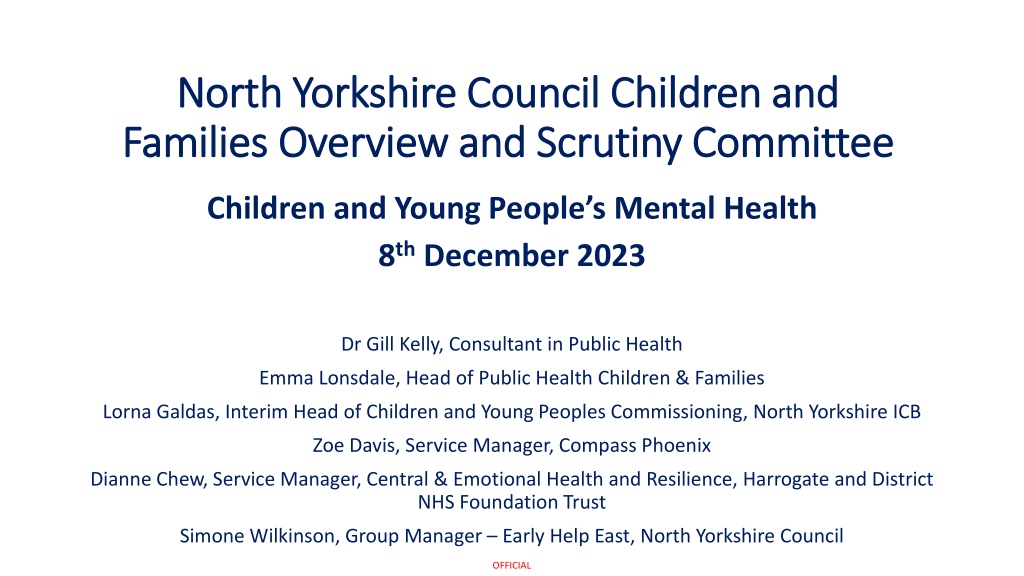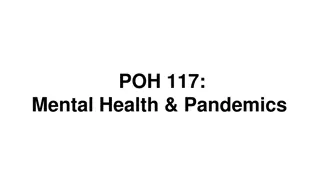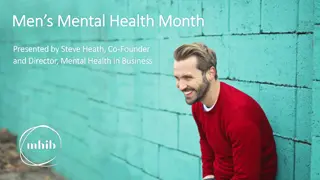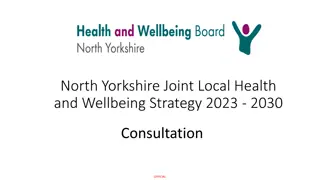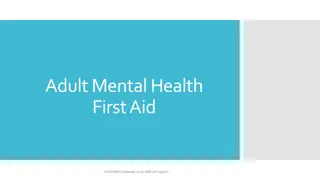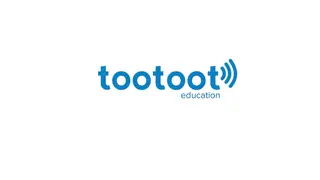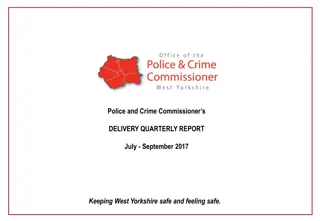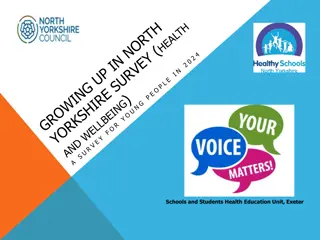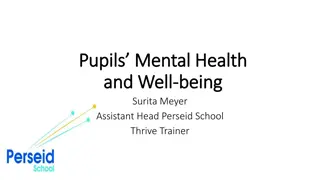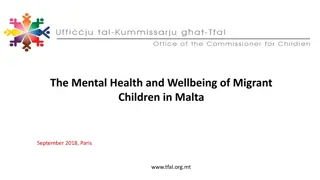Understanding Children's Mental Health in North Yorkshire: Challenges and Strategies
The impact of social isolation and educational disruption on children's mental health, especially due to the ongoing effects of the pandemic, is a key concern. This report discusses the level of impact, service pressures, unmet needs, and ways to address these challenges through a whole-system analysis approach. Insights from surveys, youth councils, community engagement, and research shed light on what makes children happy and the declining trends in wellbeing and resilience over time.
Download Presentation

Please find below an Image/Link to download the presentation.
The content on the website is provided AS IS for your information and personal use only. It may not be sold, licensed, or shared on other websites without obtaining consent from the author. Download presentation by click this link. If you encounter any issues during the download, it is possible that the publisher has removed the file from their server.
E N D
Presentation Transcript
North Yorkshire Council Children and North Yorkshire Council Children and Families Overview and Scrutiny Committee Families Overview and Scrutiny Committee Children and Young People s Mental Health 8thDecember 2023 Dr Gill Kelly, Consultant in Public Health Emma Lonsdale, Head of Public Health Children & Families Lorna Galdas, Interim Head of Children and Young Peoples Commissioning, North Yorkshire ICB Zoe Davis, Service Manager, Compass Phoenix Dianne Chew, Service Manager, Central & Emotional Health and Resilience, Harrogate and District NHS Foundation Trust Simone Wilkinson, Group Manager Early Help East, North Yorkshire Council OFFICIAL
The ask The ask The impact of social isolation and disruption to education on children and young people s mental health (particularly around the on-going legacy/effect of pandemic isolation and disruption) The level of that impact is it primarily low level anxiety, or more profound? An update on demand pressures and unmet need OFFICIAL
How to answer How to answer Service pressures and unmet need The impact of disruption on mental health and level of that impact Whole system analysis Growing Up in North Yorkshire survey North Yorkshire Youth Youth councils Flying High Healthy Schools events Other engagement National research Multi-agency workshops in our priority development Performance reviews of individual components OFFICIAL
What makes children happy? What makes children happy? It s fun where I live as I have my best mate living next door to me Overwhelmingly, what is making the children happy is being outside and being with their friends these are children who would have been born around lockdown three years ago I really do believe that in having greater community or our specific needs met in that way, that we are happier and maybe more able to make decisions that positively impact on our health in other ways too. OFFICIAL
But wellbeing and resilience has been But wellbeing and resilience has been deteriorating for longer deteriorating for longer Year 8 % of pupils with high wellbeing and resilience scores Year 10 % of pupils with high wellbeing and resilience scores 60 50 49 45 39 40 45 50 44 40 39 33 35 30 40 31 30 28 32 27 25 29 26 28 30 27 25 25 20 20 21 20 15 21 21 17 20 17 10 12 12 10 8 10 9 5 0 0 2014 2016 2018 2020 2022 2014 2016 2018 2020 2022 Boys good wellbeing Girls good wellbeing Boys good wellbeing Girls good wellbeing Good resilience Good resilience OFFICIAL
Other reasons Other reasons 11% of secondary school pupils feel pressure from social media often or all of the time "A lack of opportunities and activities for girls whose families have less money could drive them towards their phones and social media, creating even stronger unrealistic expectations in their heads." (Thomas, WHO) From Year 6 onwards between 1 in 4 and 1 in 5 have been shown something online to upset them and 10% have been bullied online (GUNY 22) "The pressures on young people start really early - to do well at school, to look good, have the right things etc. Sometimes it feels overwhelming." (Claudia, 14, WHO) We are really worried about growing out of our school uniforms. We won t be able to afford new stuff, they are so expensive. We will be getting second hand uniforms. Just feel really embarrassed in second hand stuff which then stresses me out. "The societal pressure (mainly coming from social media and the internet) for girls to fit a certain beauty standard is unlike most expectations that boys face when growing up." (Thomas, WHO)) One of my friends has got holes in her school shoes but she knows her mum hasn t got any money so she s not even telling her they are broken because she doesn t want her to worry. 62% of secondary school girls worry about their appearance vs 24% of boys (GUNY 22) 17% of secondary school pupils worry about money often or all of the time(GUNY 22) OFFICIAL
Children and young people not in school Children and young people not in school Persistent absence levels (%) in secondary schools Primary school EHE at end of academic year 22/23 Secondary school EHE at end of academic year 22/23 35 29 400 665 28 639 30 700 27 26 350 307 561 302 600 25 273 300 500 20 250 14 14 400 15 200 300 150 10 200 100 5 50 100 0 0 0 NY National Ages 5-11 Ages 12-16 2021 2021 2022 2023 2022 2023 2018/19 2021/22 2022/23 (to end of Aut term) The commonest reason for children being electively home educated is anxiety and stress, in both primary and secondary age groups At the extreme end, over a third of the Year 8 (ages 12-13) pupils had deliberately harmed themselves or thought about taking their own lives in the year prior to the survey. Nearly half of them did not tell anyone. OFFICIAL
Demand pressures and unmet need Demand pressures and unmet need OFFICIAL
Understand the system: SEMH Group Vision and Understand the system: SEMH Group Vision and Priorities Priorities 1. To ensure a single, connected system at both strategic and provider levels 2. To use data, insight and knowledge to inform all parts of the system 3. To ensure there is focus on prevention, resilience building and advice 4. We will concentrate on identifiable, vulnerable groups of children and young people 5. We will identify and respond to the areas with greatest system pressures and/or need OFFICIAL
How the local system fits How the local system fits within the within the iThrive iThrive model model OFFICIAL
Getting Advice Getting Advice The Go-To website Kooth, Craven Online wellbeing service for Bradford and Craven including councillors and wellbeing practitioners New registrations reduced this year Compass Phoenix Offering consultation and training to schools Schools feedback highlighted concerns around anxiety, stress and managing challenging behaviour Developing a webinar around challenging behaviour Main reasons for accessing: Self-harm (32%) Anxiety/stress (29%) Friendships (26%) Suicidal thoughts (24%) Progress tools show significant progress in users Large increase in numbers accessing the site in the last few months Main pages accessed, other than homepage: feeling low or extremely sad OFFICIAL
Getting help Getting help Healthy Child Service: Emotional Health and Resilience Pillar Mild to moderate needs Q2: 178 referrals Average age = 10.5 Screening within 5 days, but waits for intervention: Youth in Mind, Craven Mild to moderate needs Compass Phoenix Number of referrals for direct intervention 500 391 358 400 321 300 230 225 200 100 0 Q2 22/23 Q3 22/23 Q4 22/23 Q1 23/24 Q2 23/24 Commonest reasons for intervention: anxiety (47%) and low mood (18%) Main ages = 13/14, but increasing numbers in primary schools Improvement in waiting times for all children, with lowest waits for group interventions and Lumi-Nova 85% rated the service as good or excellent Overall increase in referrals, but significant increase since the pandemic Main age group 11-15 Sept 23 wait just over a week for an initial assessment, then just under 5 weeks from referral to second contact Q1 Q2 Central 15 wks 13 wks East 17 wks 17 wks West 17 wks 14 wks All young people s validated scoring improved by the end of interventions OFFICIAL
Getting help Getting help Mental health support teams in NY schools excl. Craven 5 teams, incl 2 in Scarborough Cover 46 schools and colleges Direct 1:1 Intervention Mental health support teams in Bradford and Craven 1 team in Craven Cover 12 schools and 1 college October 2022 September 2023: 171 children and young people treated for their mental health and wellbeing 84 90 80 70 58 60 51 51 49 50 49 40 44 38 30 36 31 20 23 21 10 0 Reasons for referral: Selby, Ham, Rich, Harr = 73-80% anxiety/panic Scarb, Rye = 52% anxiety, 28% low mood OFFICIAL
Locality Boards 5 Locality Boards serve all North Yorkshire schools, funding priorities according to local need e.g. Nurture Getting more help Getting more help SEND Locality Hubs Range of specialist support from highly qualified staff who support families, schools and a range of organisations to help children with SEND Each child has individual, clearly defined outcomes to be achieved as part of the specialist service caseload, which are shared with the child s school and family Q4 21/22 Q4 22/23: 18% increase in referrals 1573 children supported across a range of specialist services During Q4 22/23, 98% of outcomes partially or fully achieved Early Help April-Sept 2023: 19% increase in new Early Help cases Likely more than half cases have an element of SEMH, autism or ADHD Social prescriber supports young people who are seen by Compass Phoenix and/or Specialist CAMHS OFFICIAL
Getting more help Getting more help Getting risk support Getting risk support Single Point of Access into Specialist CAMHS (TEWV) (Excl. Craven) NB referral figures include City of York: Eating Disorders Service, TEWV, excl. Craven Total Referrals into TEWV 1400 1225 1112 Number of referrals 1102 1200 1326 1024 976 1000 375 400 937 800 908 843 305 791 295 600 667 300 400 200 200 148 0 100 0 19/20 20/21 21/22 22/23 Crisis referrals are similar to last year Community assessment waits (exl. ADHD): Northallerton, Harr = 2-3 weeks Scarb = 5-6 weeks Selby = 8-10 weeks New intensive support team started Jan 23: 50% reduction in critical admissions 18.5% reduction in re-admissions in 6 months OFFICIAL
Getting more help Getting more help Getting risk support Getting risk support Specialist CAMHS, Craven Large caseload increase (incl. Bradford and eating disorders and neurodiversity) Nearly 83% of children and young people were waiting less than 18 weeks from referral to starting treatment in September 2023 There is a directory of support services and safe and well checks whilst waiting OFFICIAL
Autism Autism Craven Provider BDCFT Data includes all neurodiversity Waiting list = 132 children (May 23) A new child added to the waiting list from May 23 could wait around 38 months Diagnosis made in over 80% Scarborough/Whitby/ Ryedale Provider ABL Capacity 20 referrals/month Demand 27 referrals/month Waiting list = 114 children (Sept 23) Average assessment wait = 44 weeks (Sept 23) Autism diagnosis made in 71-81% (Jan-Sept 23) Harrogate/Ham&Rich Provider HDFT Capacity 40 referrals/month Demand 80 referrals/month Waiting list = 1044 children (Sept 23) Ave assessment wait = 58 wks Autism diagnosis made in 92-100% (Jan-Sept 23) New referral system with triage to offer support earlier NB new all-age autism strategy consultation currently live OFFICIAL
Multiple different programmes of work across our North Yorkshire schools, providing support and and promoting wellbeing. Most secondary schools have a Mental Health Lead and all education settings offer pastoral support. Schools Schools Healthy Schools Awards Programme Over 80% of primary schools signed up and working towards awards Online event, March had 2,000 pupils RHS Harlow Carr in June East Barnby Outdoor Learning Centre November 27th My Happy Mind Currently in 12 primary schools in Scarborough (+ 4 pending) 80% of staff are now having 1-3 conversations about children s wellbeing each week 93% of teachers said that Happy Breathing benefited their class: Make sure everyone has someone to play with - if we see someone on their own, we ask them to join in Teachers take time to talk to you when you're sad." "We have well-being brain breaks." OFFICIAL
Final points Final points Further work within our priorities Single connected system Mental health transformation project Data, insight and knowledge SEND data dashboard Focus on prevention and resilience Thriving mapping group in Selby Concentrate on vulnerable groups Emotionally based school avoidance Transitions to adult services Identify and respond to system pressures Attachment and trauma awareness in schools Emerging eating disorders Anglo-American project for wellbeing What more would make a difference? Increased capacity in all parts of the system More wellbeing programmes in schools and communities Support for staff in non-clinical organisations OFFICIAL
Conclusion Conclusion Children are amazing! Our whole population has shifted to be less resilient, with poorer wellbeing how big a shift is open for debate Our job, therefore, is to focus on prevention, resilience, wellbeing, providing extra support as needed Workforce are amazing! Dedicated and professional, going above and beyond OFFICIAL
